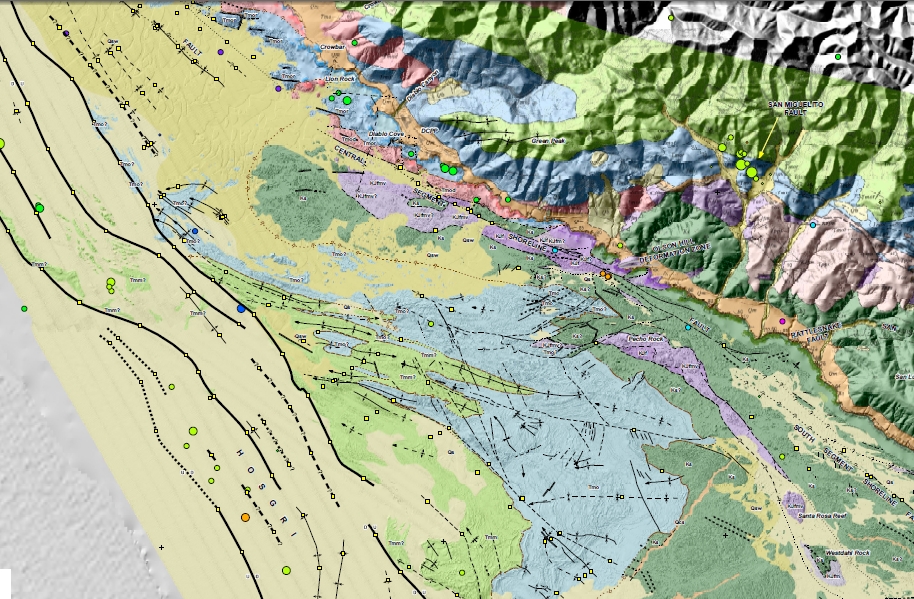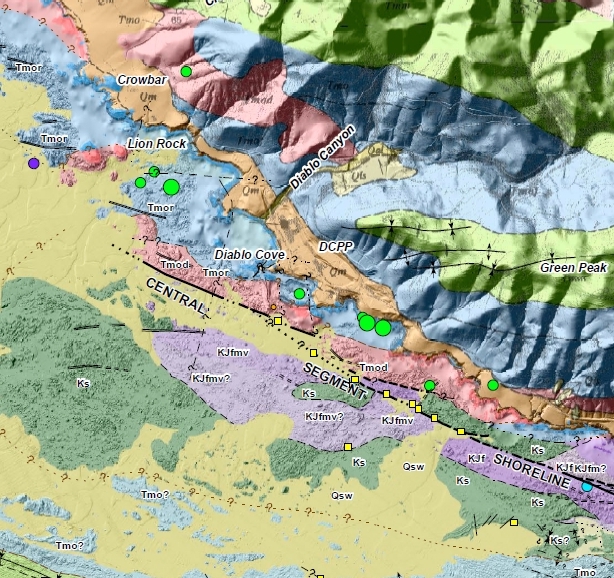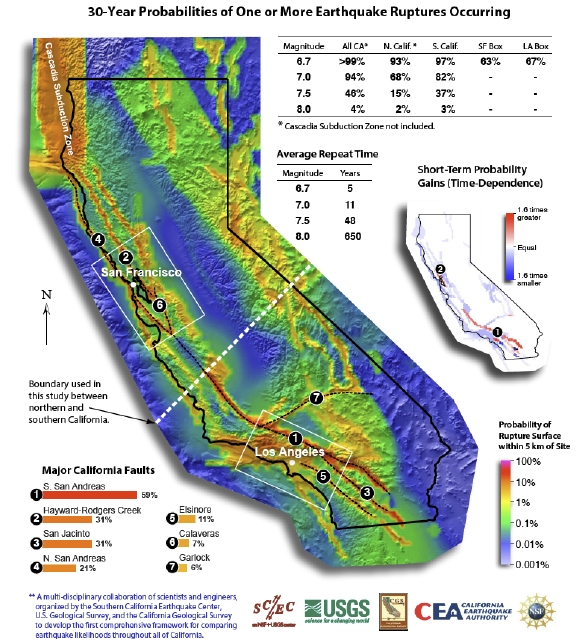The California Energy Commission (CEC) will be holding hearings on July 26th concerning the state’s long term power needs. Last spring the CEC sent out data requests to both Pacific Gas & Electric Company (PG&E) and Southern California Edison (SCE) concerning safety related issues at their nuclear facilities. The CEC list of questions was extensive. Both PG&E and SCE have replied to CEC’s data request and those documents were made public on July 14th. It should be noted that PG&E did not respond to a single question, but instead submitted 36 seismic reports several hundred pages long, which much of came from their January 2011 Shoreline report to the NRC.
In 2006, the state of California passed AB1632 which gave the CEC the authority to investigate seismic safety issues at the state’s nuclear facilities. This authority was informally contested by PG&E in conversations between the utility company and the Nuclear Regulatory Commission (NRC).
This is a review of PG&E and SCE’s submissions to the CEC’s April 22nd IEPR data request in the context or this post Fukushima era. Their annual Integrated Energy Policy Report (IEPR) is used by the CEC as well as the California Public Utilities Commission (CPUC) to plan, manage and finance the state’s massive energy infrastructure. There are additional investigations going on within the California Public Utilities Commission (CPUC), thanks to WEM for getting to first base on this, as it was their filing that opened the CPUC to consider the idea closing Diablo and SONGS with the state currently awash in excess power.
On June 22nd 2003, there was a 6.5 quake that struck 50 KM northwest of Diablo Canyon. I think it was this quake that set off what has been a renewed concern about the continued operation of DCPP. This was again expanded with the discovery of the Shoreline faultline that is just a few hundred meters from the reactors.
The CEC’s IEPR 2009 report included details of how the Nuclear Regulatory Commission (NRC) had purposely changed specific guidance standards that would have precluded PG&E from being able to relicense Diablo Canyon for an additional 20 years. To date the
NRC has never failed to relicense a single nuclear power plant, with the most blatant example when the NRC gave Entergy a new license for operating the Vermont Yankee facility less than a week after Fukushima. This flies in the face of the state of Vermont’s legislature that voted to shut down aging facility after years of accidents and serious tritium leaks. A recent AP investigation disclosed the agencies “Captured” status, protecting the industry rather than the public safety.
PG&E and the NRC will likely challenge the CEC’s state authority from AB1632, which can be seen with their refusal to answer any of the CEC’s questions. The state does however, have jurisdiction over the state’s power procurement needs and could decide it no longer was willing to pay for Diablo or SONGS’ power. Thus the resulting investigation.
Summary of Responses to the CEC’s 4-25-2011 11-IEPR Request
- PG&E’s submission to date has not responded to a single CEC question
- SCE’s response to CEC’s question A.01 on AB1632/SONGS status was answered here.
- SCE’s Response on A.02 using 3D seismic studies was answered here.
- SCE Refused to answer Question A.03 regarding use of USGS’s national mapping project.
- SCE Response to A.04 whether SONGS should have a similar long term seismic program as Diablo Canyon was answered here.
- SCE’s Response to A.05 long term seismic ground shifts was answered here.
- SCE’s Response to A.07 or concerns about loss of power was answered here.
- SCE’s Response to A.09 concerns about components that could lead to extended loss of power was answered here.
- SCE’s Response to A.10 concerns about spent fuel fires was answered here.
- SCE’s Response to A.11 – Emergency planning included an estimate of up to 18 hours to evacuate the public in case Meltdown. Their response included details of their emergency planning regime. They concluded that they don’t believe they need to change anything in their current Emergency Plan.
- SCE’s Response to A.12 was that they would generate 7,500 cubic feet of Class A and 100 cubic feet of Class B & C wastes per year, 550 cubic feet of Mixed Wastes, and 27,000 cubic feet from the disposal of old steam generators.
- There are 52 additional answers beyond the 12 listed above.
The 7-26 hearings could become a major step in the state of California moving towards closure of state’s nuclear reactors. For now, the attempt by PG&E to prematurely push through a twenty year extension has been put on hold. The concerns that the Shoreline fault could generate a 7.2 earthquake with its location being from 300 to 800 yards from Diablo Canyon would exceed the design capacity the reactors were designed to withstand.
The 3D studies that will help clarify the issue are being done, however, as the world saw in Fukushima, can we trust the self interests of PG&E or SCE?
During the 3-21-2011 state hearings SCE stated on the record that its seismic program was adequate and that its seawall was 30 foot high. Activists measured that seawall and point out that during high tide it is only 14 feet. The same height of Fukushima’s seawall. With the recent acknowledgement that a super quake (Cascadia) could generate a tsunami above these levels, there are concerns that SONG’s could be in danger not just from quakes but also flooding.
Additional resources have been posted over the last week. They include:
- presentations by various state and utility officials
- CEC’s AB1632 (2008) Assessment of California nuclear facilities
Here is my first assessment of what has happened:
1. The World Nuclear Association claimed that Japan’s nuclear reactors were designed using a 1,000 year Probabilistic Risk Assessment model.
2. When Diablo Canyon was designed and built the IOU’s PRA’s failed to include evaluate any historic seismic evidence even going back 50 years let alone 1,000 years.
3. It is a well known fact that PG&E was forced to do additional seismic design work at Diablo Canyon twice prior to licensing.
4. What isn’t well known is that the NRC refused to allow the public to evaluate the confluence of a major earthquake, a nuclear accident and the ability to to safely evacuate the public.
a. Whether or not a federal judge decided or not to look at the NRC’s own leaked transcripts that clearly showed the agency’s failure to deal with such an event for both Diablo Canyon or SONGS, the fact is that the sole agency in charge of protecting the public from such an event has never let the public protect itself.
5. The state of the Geophysics has come far in the last 30 years. However, as publicly stated on National TV during the “Nova” program on the 3-11 Tohoku quake, there is clearly more yet to know.
6. The country of Japan gambled with the economic and environmental well being of its people and lost. It did so making public claims that such an event was not possible. It is well known that in making these claims the country’s nuclear industry also cut every corner possible to minimize costs. Or more to the point, there was a massive difference between what today would be called the precautionary principle and the nuclear industry’s “Cost Benefit” analysis agenda.
7. As now being fought over by Japan, the world is watchng the 5th largest electric company in the world’s financial status on the verge of total collapse with Japan’s banks demanding that the company be bailed out. The company has already been granted over 2 trillion yen in loans this year.
8. Several major US financial institutions have suggested that claims against the country could range between $25-50 billion. The US Price Anderson Act precludes accident claims above $12 billion. This does not include cleanup and decommissioning costs or replacement power costs, let alone the impacts on the country’s agricultural export economy.



